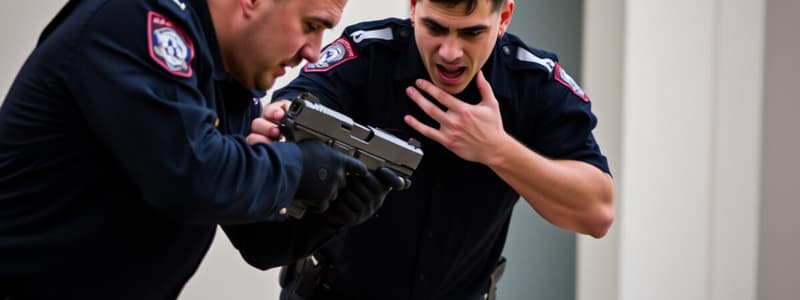Podcast
Questions and Answers
Define deadly force.
Define deadly force.
Force that a person uses causing, or that a person knows or should know would create a substantial risk of causing death or serious bodily harm.
What does the term 'force' mean?
What does the term 'force' mean?
To do violence; to compel by physical or intellectual means.
What constitutes serious bodily harm?
What constitutes serious bodily harm?
Fractured or dislocated bones, deep cuts, torn members of the body, serious damage to internal organs, other life-threatening injuries.
What does 'imminent' mean in a threat context?
What does 'imminent' mean in a threat context?
What are the standing rules for the use of force for US forces?
What are the standing rules for the use of force for US forces?
What is meant by combat mindset?
What is meant by combat mindset?
What is alertness?
What is alertness?
What does decisiveness mean in actions taken?
What does decisiveness mean in actions taken?
Define aggressiveness in the context of use of force.
Define aggressiveness in the context of use of force.
What does speed of action refer to?
What does speed of action refer to?
What is self-control?
What is self-control?
What is determination in relation to force?
What is determination in relation to force?
WHITE - STAGE describes a state of _____.
WHITE - STAGE describes a state of _____.
YELLOW - STAGE indicates a state of _____.
YELLOW - STAGE indicates a state of _____.
ORANGE - STAGE is defined as a state of _____.
ORANGE - STAGE is defined as a state of _____.
RED - STAGE refers to being mentally prepared to use _____.
RED - STAGE refers to being mentally prepared to use _____.
Judgment is the most important trait required to effectively employ the _____.
Judgment is the most important trait required to effectively employ the _____.
What are the 2 general types of subjects?
What are the 2 general types of subjects?
What characterizes a passive compliant subject?
What characterizes a passive compliant subject?
What is an active aggressor?
What is an active aggressor?
What is the role of non-lethal force?
What is the role of non-lethal force?
List the three components of the deadly force triangle.
List the three components of the deadly force triangle.
What is the authority to arm personnel vested in?
What is the authority to arm personnel vested in?
What is required on DD Form 2760?
What is required on DD Form 2760?
Warning shots are authorized within U.S. territory.
Warning shots are authorized within U.S. territory.
What is the definition of de-escalation?
What is the definition of de-escalation?
What does OODA stand for?
What does OODA stand for?
Flashcards are hidden until you start studying
Study Notes
Definitions and Key Concepts
- Deadly Force: Force that can cause death or serious bodily harm, understood through the substantial risk involved.
- Force: Involves violence; compelling someone through physical or intellectual means.
- Serious Bodily Harm: Includes severe injuries such as fractured bones, deep cuts, and life-threatening damage to internal organs.
Risk Assessment
- Imminent Threat: A threat that is likely to occur soon; the assessment considers all known circumstances.
- Judgment: Essential trait for effective use of force; sound judgment guides appropriate responses.
Mindset and Readiness
- Combat Mindset: Mental preparedness is crucial for achieving favorable outcomes in conflict.
- Alertness: Maintaining focus on potential threats to avoid surprises; always remain vigilant.
- Decisiveness: The ability to determine an action plan and execute it effectively.
Stages of Situational Awareness
- White Stage: Complete vulnerability; unaware of surroundings.
- Yellow Stage: General alertness to the environment.
- Orange Stage: Specific focus on potential threats.
- Red Stage: Prepared to use deadly force; criteria for engagement met.
- Black Stage: Overwhelmed by stimuli; impairs decision-making.
Response Techniques
- Aggressiveness: After deciding to use force, maintain control until the situation is secured.
- Speed of Action: Ensure actions are quick and deliberate to effectively neutralize threats.
- Self Control: Focused approach on addressing one issue at a time during conflict.
Subject Types and Force Continuum
- Types of Subjects: Classified into passive, active resistors, and aggressors based on behavior.
- Force Continuum Levels: Progresses from presence, verbal commands, soft control, to deadly force, depending on the subject's response.
Force Continuum Details
- Passive Subjects: Follow directions (Passive Compliant) or do not comply (Passive Resistor).
- Active Subjects: Include those who resist without attacking (Active Resistor) and those who physically attack (Active Aggressor).
Levels of Force
- Presence: Displaying authority visually through uniform.
- Non-Lethal Force: Examples include baton use aimed at legs.
- Deadly Force Triangle: Comprises capability, opportunity, and intent.
Key Definitions for Use of Force
- Capability: Means to inflict harm; possessing a weapon.
- Opportunity: Proximity of a weapon to inflict harm.
- Intent: Demonstrated willingness to cause harm, shown through aggressive actions.
Authorization and Documentation
- Authority to Arm: Vested in Commanding Officers (CO).
- OPNAV Form 5512/2: Written authorization for personnel to carry firearms.
- DD Form 2760: Required completion for firearms carrying; no domestic violence convictions.
Use of Force Guidelines
- Shooting Protocol: Should prioritize the safety of bystanders.
- Warning Shots: Prohibited in U.S. territory, except for force protection.
- Weapon Unholstering: Should be reserved for reasonable certainty of need.
Training and Application
- Training Requirements: Include qualifications on weapons, use of force, and rules of engagement.
- Application of Force: Should follow a progressive and sequential approach.
- De-escalation: Providing the opportunity for withdrawal to the threatening individual when circumstances allow.
Tactical Considerations
- OODA Loop: Observe, orient, decide, act; a driving force in applying the use of force continuum.
- Non-Lethal Weapons (NLW): Offer options that complement, but do not replace deadly force.
- Proportional Force: Engagement scope should not exceed what is necessary to counter the threat effectively.
Studying That Suits You
Use AI to generate personalized quizzes and flashcards to suit your learning preferences.

